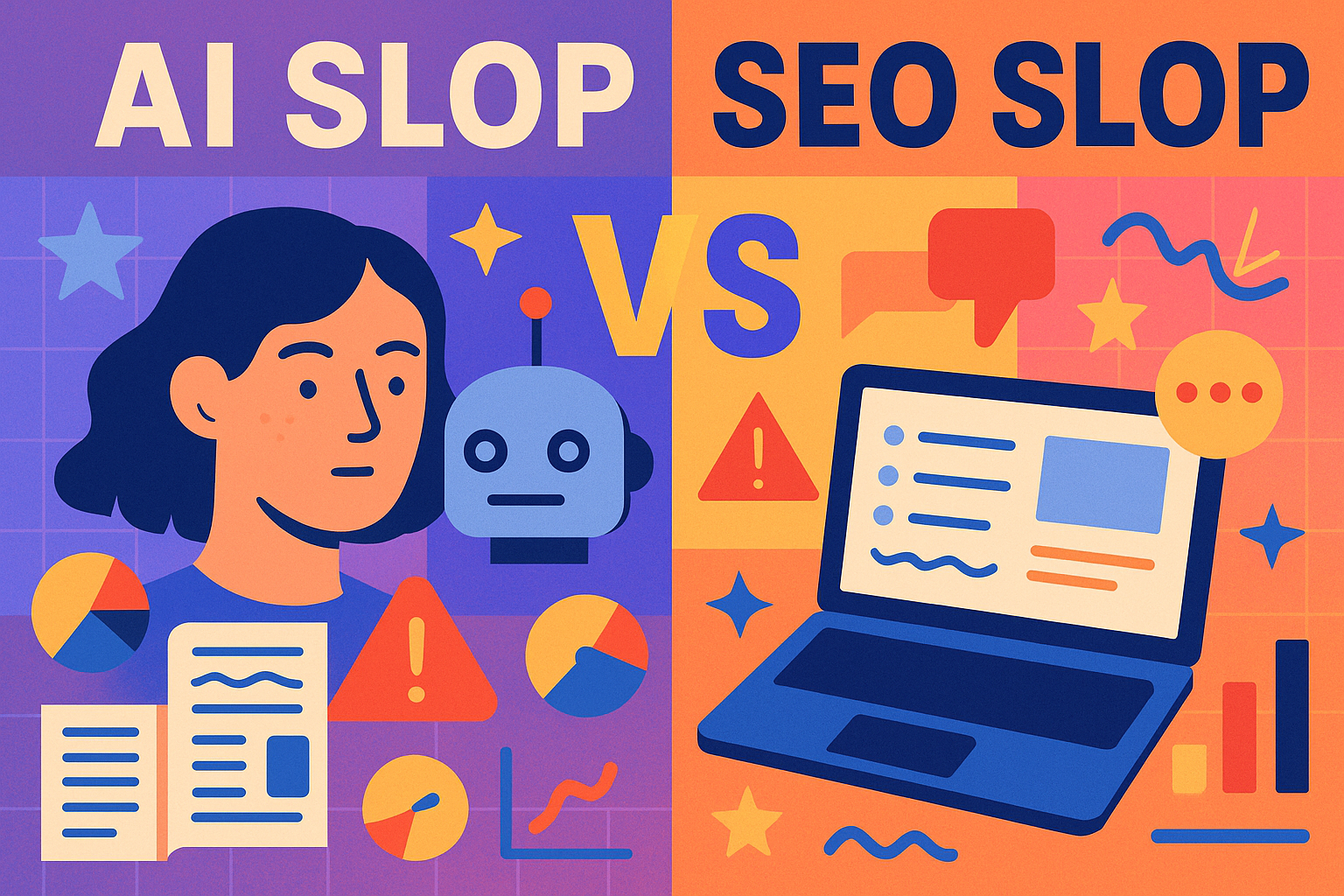Introduction: The Battle of Low-Quality Content
The internet is drowning in content. Some of it is brilliant—insightful, data-driven, and genuinely helpful. But much of it falls into a category that experts now call “slop.” Two major forms dominate: AI slop and SEO slop. Both undermine user experience, clutter search results, and make it harder for genuine creators to shine.
But what exactly do these terms mean? And more importantly, how can readers spot low-quality content before wasting their time? Let’s dive deep into the world of AI slop vs SEO slop.
What is AI Slop?
AI slop refers to low-quality, machine-generated text that is:
- Repetitive and generic
- Filled with vague statements
- Lacking human insight or originality
- Often designed to meet word count rather than provide value
While AI can be powerful, poorly managed use creates walls of meaningless text. For example, a recipe blog generated by AI might repeat “This dish is delicious and healthy” ten times without offering unique cooking insights.
What is SEO Slop?
SEO slop existed long before AI content flooded the web. It’s content written primarily to rank on Google, not to help readers. It typically includes:
- Keyword stuffing: awkwardly repeating keywords like “best running shoes 2025” ten times in one paragraph.
- Clickbait titles: promises something revolutionary, delivers shallow text.
- Thin affiliate content: product roundups written only to push sales links.
SEO slop is optimized for algorithms, not humans.
Why Both Hurt the Internet
- User trust erodes: Readers quickly learn to ignore sites filled with fluff.
- Search results get polluted: Valuable content gets buried under repetitive junk.
- Creators lose motivation: Authentic writers see their work outperformed by spammy tactics.
- Advertisers waste money: Display ads appear on sites that don’t engage real audiences.
How to Spot AI Slop
- Repetition of phrases: The same idea reworded in multiple sentences.
- Lack of specifics: Generalizations with no examples or data.
- Weird tone shifts: AI sometimes changes style mid-paragraph.
- Overlong intros: Several paragraphs before giving useful info.
- Fact-checking issues: Outdated or incorrect statistics.
(Example: An AI slop article on fitness might tell you “exercise improves health” 12 times without naming one actual workout.)
How to Spot SEO Slop
- Keyword stuffing: Reading feels unnatural due to forced keywords.
- No real author: Lacks a byline or expert profile.
- Affiliate overload: Every sentence pushes you to “buy here.”
- Listicles with no depth: “Top 10 gadgets” with no explanation of why they’re useful.
- Thin content: Word count padded with filler sentences.
Real-World Examples (Without Naming Sites)
- AI Slop Example: A blog promising “The Future of AI in Healthcare” but offering no expert quotes, just repeating generic benefits like “AI improves efficiency.”
- SEO Slop Example: A 3,000-word article on “Best Laptops for Students” with 50 Amazon affiliate links but no actual performance analysis.
The Middle Ground: Good AI + Smart SEO
Not all AI-generated or SEO-optimized content is bad. When used responsibly:
- AI can help: Brainstorming ideas, summarizing research, or assisting non-native writers.
- SEO can guide: Ensuring your content matches what readers are searching for.
The key lies in balance: blending authentic human insight with smart SEO practices.
Why Readers Should Care
Low-quality slop wastes time, spreads misinformation, and makes it harder to find trustworthy information. By learning to spot the red flags, readers can:
- Save time
- Support quality creators
- Push search engines to prioritize authentic voices
How Creators Can Avoid Producing Slop
- Prioritize value over word count.
- Use keywords naturally—focus on clarity, not density.
- Add original research or opinion—what’s your unique take?
- Cite sources—back claims with real data.
- Respect readers’ time—deliver useful info upfront.
Tech & Culture: Why This Matters
The battle between AI slop and SEO slop isn’t just about search results—it reflects broader cultural shifts:
- Attention economy: Short attention spans crave authentic, fast answers.
- AI ethics: The debate around responsible use of generative AI.
- Digital trust: Readers want transparency in who writes what.
Internal & External Linking Opportunities
- Internal links idea: Link to Scrollistan articles on AI trends, digital ethics, or content marketing.
- External links idea: Reference Google’s Helpful Content Update or research papers on AI writing quality.
Suggested Image Ideas
- Side-by-side infographic: “AI Slop vs SEO Slop.” (Alt text: comparison of low-quality AI and SEO content)
- Illustration of “content farm” factory. (Alt text: factory producing low-quality text)
- Magnifying glass over web results. (Alt text: analyzing search results for quality)
Meta Details
- Meta Title: AI Slop vs SEO Slop: Spotting Low-Quality Content Online
- Meta Description: Explore the rise of AI-generated slop and SEO-driven filler. Learn how to spot low-quality content and why it matters for readers and creators.
- URL Suggestion: scrollistan.com/ai-slop-vs-seo-slop
Conclusion & Call-to-Action
AI slop and SEO slop are two sides of the same coin—content created without the reader in mind. As AI grows more powerful and SEO tactics more advanced, the internet risks becoming noisier than ever. The solution isn’t to reject AI or SEO but to demand quality, originality, and honesty.
👉 What do you think? Have you spotted AI or SEO slop recently? Share your thoughts in the comments and let’s build a cleaner, smarter internet together.
